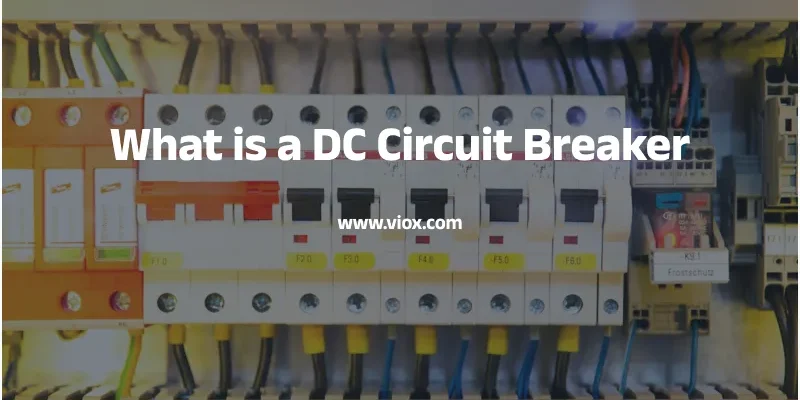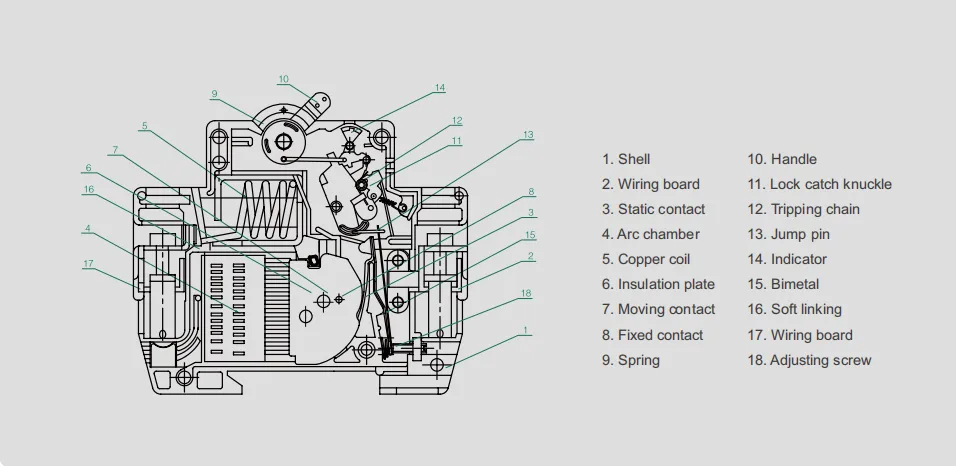Un interruttore automatico CC è un dispositivo di protezione specializzato progettato per interrompere automaticamente il flusso di corrente continua in caso di condizioni pericolose come sovracorrenti, cortocircuiti o guasti elettrici. A differenza dei loro omologhi CA, gli interruttori automatici CC sono progettati per gestire le sfide specifiche dei sistemi a corrente continua, in cui l'elettricità scorre continuamente in una sola direzione senza i naturali punti di attraversamento per lo zero tipici della corrente alternata.
Questi dispositivi di sicurezza essenziali costituiscono la prima linea di difesa nei sistemi elettrici a corrente continua, proteggendo apparecchiature di valore, prevenendo incendi di origine elettrica e garantendo la sicurezza del personale che lavora con impianti di alimentazione a corrente continua.
Come funzionano gli interruttori automatici CC: il processo completo
Capire il funzionamento degli interruttori automatici in corrente continua è fondamentale per chiunque lavori con sistemi a corrente continua. Il processo di protezione prevede diverse fasi coordinate che si verificano entro pochi millisecondi dal rilevamento del guasto.
Monitoraggio e rilevamento attuali
Gli interruttori automatici CC monitorano costantemente il flusso di corrente attraverso meccanismi di rilevamento integrati. Questi sensori, in genere solenoidi o trasformatori di corrente, generano segnali proporzionali in base all'intensità della corrente che attraversa il circuito. Il sistema di monitoraggio è attivo 24 ore su 24, 7 giorni su 7, garantendo il rilevamento immediato di condizioni anomale.
Elaborazione e analisi del segnale
Quando il meccanismo di rilevamento della corrente rileva condizioni anomale, invia segnali allo sganciatore, il cervello dell'interruttore. Questo sofisticato componente analizza i segnali di corrente in ingresso e li confronta con soglie e caratteristiche predeterminate. Gli sganciatori moderni sono in grado di distinguere tra fluttuazioni temporanee di corrente e reali condizioni di guasto.
Errore di Rilevamento e Risposta
L'unità di sgancio valuta costantemente il segnale di corrente per individuare vari tipi di guasto, tra cui sovraccarichi, cortocircuiti e guasti a terra. Quando la corrente supera i limiti predefiniti o presenta andamenti anomali, il sistema riconosce immediatamente una condizione di guasto e si prepara ad adottare misure di protezione.
Processo di interruzione del circuito
In caso di rilevamento di un guasto, lo sganciatore genera un segnale di sgancio che attiva il meccanismo di azionamento dell'interruttore. Questo innesca la rapida separazione dei contatti, interrompendo fisicamente il flusso di corrente e scollegando il circuito guasto dalla fonte di alimentazione. La velocità di questo processo è fondamentale per prevenire danni.
Tecnologia di soppressione degli archi
Quando i contatti si separano sotto carico, si verifica un arco elettrico poiché la corrente cerca di mantenere il suo percorso. Gli interruttori automatici in corrente continua impiegano metodi specializzati per la soppressione dell'arco, tra cui bobine di spegnimento magnetiche, camere di compensazione e sistemi a gas pressurizzato, per estinguere rapidamente gli archi e prevenirne la riaccensione.
Componenti essenziali degli interruttori automatici CC
Comprendere i componenti interni degli interruttori automatici in corrente continua è fondamentale per una corretta selezione, installazione e manutenzione. Ogni componente svolge un ruolo specifico nel garantire una protezione affidabile del circuito e un funzionamento sicuro.
Componenti strutturali
Conchiglia (1) – Il robusto involucro esterno protegge tutti i componenti interni dagli agenti atmosferici, garantendo al contempo l'isolamento elettrico. Il guscio è in genere realizzato con materiali termoplastici o termoindurenti di alta qualità, in grado di resistere a sollecitazioni meccaniche e carichi elettrici.
Scheda di cablaggio (2, 17) – Schede elettroniche interne che ospitano i collegamenti elettrici e forniscono punti di montaggio per vari componenti. Queste schede garantiscono percorsi elettrici adeguati e facilitano l'organizzazione del cablaggio interno.
Piastra isolante (6) – Componente di sicurezza fondamentale che garantisce l'isolamento elettrico tra diversi livelli di tensione all'interno dell'interruttore, prevenendo percorsi elettrici indesiderati e garantendo un funzionamento sicuro.
Sistema di contatto
Contatto statico (3) – Il contatto elettrico fisso che rimane in posizione durante il funzionamento dell'interruttore. Fornisce metà del collegamento elettrico quando l'interruttore è chiuso.
Contatto in movimento (7) – Il contatto mobile che si apre e si chiude contro il contatto statico per aprire o chiudere il circuito elettrico. La sua precisione di movimento è essenziale per un funzionamento affidabile.
Contatto fisso (8) – Un altro punto di contatto fisso che funziona insieme al sistema di contatto mobile per garantire una corretta connessione elettrica e l'interruzione del circuito.
Gestione dell'arco
Camera ad arco (4) – Un compartimento appositamente progettato che contiene e controlla gli archi elettrici durante l'interruzione del circuito. Questa camera utilizza diverse tecniche per raffreddare ed estinguere gli archi in modo rapido e sicuro.
Bobina di rame (5) – Una bobina elettromagnetica che crea campi magnetici per aiutare a spegnere gli archi elettrici durante l'interruzione del circuito. La struttura in rame garantisce un'elevata conduttività e un'efficiente generazione di campo magnetico.
Meccanismo di funzionamento
Maniglia (10) – La leva di comando esterna che consente l'azionamento manuale dell'interruttore. Gli utenti possono aprire o chiudere manualmente l'interruttore e ripristinarlo dopo un evento di sgancio.
Primavera (9) – Fornisce l'energia meccanica necessaria per un rapido movimento dei contatti durante le operazioni di sgancio. Il sistema a molla garantisce una rapida separazione dei contatti quando è necessaria la protezione.
Nocca di bloccaggio (11) – Un meccanismo di bloccaggio meccanico che mantiene i contatti dell'interruttore in posizione chiusa durante il normale funzionamento e li rilascia in caso di sgancio.
Catena di sgancio (12) – Il collegamento meccanico che trasferisce il segnale di sgancio dal sistema di protezione al meccanismo di azionamento del contatto, garantendo un funzionamento affidabile dello sgancio.
Perno di salto (13) – Un componente meccanico che fornisce un controllo preciso del movimento durante la sequenza di attivazione, garantendo tempi e forza adeguati.
Elementi di protezione e controllo
Bimetallico (15) – Un elemento di protezione termica costituito da due metalli diversi con diverse velocità di dilatazione. Quando riscaldato da sovracorrente, il bimetallo si piega e attiva il meccanismo di sgancio per la protezione termica.
Collegamento morbido (16) – Collegamenti meccanici flessibili che consentono movimenti precisi, tenendo conto della dilatazione termica e delle tolleranze meccaniche.
Vite di regolazione (18) – Consente la regolazione fine delle caratteristiche di intervento e della pressione di contatto per ottimizzare le prestazioni dell'interruttore per applicazioni specifiche.
Indicazione di stato
Indicatore (14) – Sistema di indicazione visiva che mostra lo stato attuale dell'interruttore (aperto, chiuso o scattato), fornendo agli utenti un importante feedback operativo.
Questi componenti lavorano insieme in un coordinamento preciso per fornire una protezione affidabile del circuito. Gli elementi termici reagiscono alle sovracorrenti prolungate, mentre gli elementi magnetici forniscono una protezione istantanea contro i cortocircuiti. Il sistema meccanico garantisce un funzionamento rapido e affidabile, mentre i componenti di gestione dell'arco gestiscono in modo sicuro l'energia elettrica rilasciata durante l'interruzione del circuito.
L'ispezione regolare di questi componenti durante la manutenzione contribuisce a garantire un funzionamento affidabile e continuo e a identificare potenziali problemi prima che possano causare guasti.
Principali vantaggi degli interruttori automatici CC
Gli interruttori CC offrono diversi vantaggi significativi rispetto alle alternative CA, in particolare nelle applicazioni in cui la corrente continua è la fonte di alimentazione primaria.
Capacità superiori di estinzione dell'arco
Gli interruttori automatici in corrente continua (CC) eccellono nella gestione e nell'estinzione degli archi in corrente continua (CC), che sono intrinsecamente più complessi degli archi in corrente alternata (CA) a causa dell'assenza di punti di attraversamento per lo zero naturali. Questi interruttori incorporano meccanismi specializzati di soppressione dell'arco in grado di raffreddarsi ed estinguere rapidamente gli archi, prevenendo danni alle apparecchiature e garantendo un'interruzione affidabile del circuito.
Caduta di tensione ridotta
Gli interruttori automatici in corrente continua (CC) presentano in genere cadute di tensione inferiori sui contatti rispetto agli interruttori in corrente alternata (CA). Questa caratteristica si rivela particolarmente vantaggiosa nelle applicazioni che richiedono un controllo preciso della tensione, poiché riduce al minimo le perdite di potenza e consente una gestione più accurata del sistema.
Tempi di risposta più rapidi
Senza dover attendere punti di passaggio per lo zero, gli interruttori automatici in corrente continua (CC) possono rilevare e risolvere i guasti più rapidamente rispetto ai loro omologhi in corrente alternata. Questa risposta rapida offre una maggiore protezione contro cortocircuiti e altre condizioni pericolose, prevenendo potenzialmente danni estesi alle apparecchiature collegate.
Design compatto
Gli interruttori automatici in corrente continua (CC) presentano generalmente una struttura più compatta rispetto agli interruttori CA equivalenti con correnti nominali simili. Il design più snello è il risultato dei requisiti intrinsecamente più semplici dei sistemi in CC e del minor numero di componenti operativi.
Selettività migliorata
Gli interruttori automatici CC offrono una selettività migliorata, il che significa che solo la sezione specifica del circuito difettoso viene isolata durante un guasto, lasciando operativo il resto del sistema. Questa operazione selettiva riduce i tempi di fermo e riduce al minimo le interruzioni ai sistemi CC collegati.
Tipi di interruttori automatici CC
La diversità delle applicazioni CC ha portato allo sviluppo di vari tipi di interruttori automatici, ciascuno ottimizzato per specifici requisiti operativi.
Interruttori magnetotermici
Questi interruttori versatili combinano elementi termici che reagiscono al calore generato da sovracorrente con elementi magnetici che reagiscono a livelli di corrente elevati. Il doppio meccanismo di protezione offre una copertura completa per un'ampia gamma di condizioni di guasto, rendendoli popolari in applicazioni residenziali e commerciali.
Interruttori elettronici
Utilizzando componenti elettronici avanzati, questi interruttori offrono tempi di risposta più rapidi e impostazioni di protezione regolabili. Gli sganciatori elettronici possono essere programmati per applicazioni specifiche, fornendo una protezione da sovracorrente personalizzabile con elevata precisione e affidabilità.
Interruttori automatici allo stato solido
Rappresentando l'avanguardia della tecnologia di protezione dei circuiti, gli interruttori allo stato solido sostituiscono i tradizionali componenti meccanici con dispositivi a semiconduttore. Queste unità avanzate possono interrompere la corrente in microsecondi e offrono funzionalità come il monitoraggio remoto, il controllo preciso e l'integrazione con i sistemi di smart grid.
Interruttori automatici CC ad alta tensione
Specificamente progettati per applicazioni HVDC, questi interruttori affrontano le sfide estreme dei sistemi in corrente continua ad alta tensione. Impiegano tecniche sofisticate per creare zeri di corrente artificiali, consentendo un'interruzione affidabile dei circuiti in corrente continua ad alta tensione.
Interruttori automatici miniaturizzati (MCB CC)
Gli interruttori magnetotermici DC sono dispositivi di protezione compatti progettati per applicazioni a bassa corrente, in genere da 6 A a 63 A. Questi interruttori sono comunemente utilizzati in impianti solari residenziali, piccoli sistemi commerciali e quadri elettrici industriali.
Interruttori automatici scatolati (DC MCCB)
Gli interruttori magnetotermici scatolati (MCCB) in corrente continua gestiscono correnti nominali più elevate, in genere da 100 A a 2500 A, rendendoli adatti ad applicazioni industriali di grandi dimensioni, sistemi di accumulo di energia e impianti solari commerciali. Offrono impostazioni di intervento regolabili e capacità di interruzione migliorate.
Applicazioni critiche degli interruttori automatici CC
Gli interruttori automatici CC svolgono un ruolo fondamentale in numerosi settori e applicazioni in cui l'alimentazione a corrente continua è essenziale.
Sistemi solari fotovoltaici
Negli impianti solari, gli interruttori automatici CC proteggono i pannelli fotovoltaici, i quadri elettrici e gli ingressi degli inverter da sovracorrenti. Consentono procedure di manutenzione sicure e forniscono capacità di isolamento essenziali per la risoluzione dei problemi e le riparazioni.
Sistemi di accumulo di energia a batteria
Gli impianti di accumulo di energia si affidano a interruttori automatici in corrente continua per proteggere i costosi banchi di batterie da sovracorrenti, cortocircuiti e correnti inverse. Questi interruttori garantiscono operazioni di carica e scarica sicure, proteggendo al contempo da potenziali situazioni di fuga termica.
Infrastruttura di ricarica per veicoli elettrici
Le stazioni di ricarica rapida in corrente continua (CC) utilizzano interruttori automatici in corrente continua ad alta potenza per proteggere le apparecchiature di ricarica e i veicoli da guasti elettrici. Queste applicazioni richiedono tempi di risposta rapidi e un'elevata capacità di interruzione per gestire i notevoli livelli di potenza coinvolti.
Data Center e Telecomunicazioni
Le infrastrutture critiche utilizzano interruttori automatici in corrente continua nei sistemi di alimentazione di backup, nelle apparecchiature di telecomunicazione e nei circuiti di illuminazione di emergenza. L'affidabilità e la rapidità di risposta di questi interruttori sono essenziali per garantire la continuità operativa.
Applicazioni marine e aerospaziali
Navi, aerei e veicoli spaziali utilizzano interruttori automatici in corrente continua in sistemi essenziali in cui peso, affidabilità e prestazioni sono fondamentali. Queste applicazioni specializzate richiedono spesso interruttori progettati su misura e conformi a rigorosi standard di certificazione.
Come selezionare il giusto interruttore automatico CC
Per scegliere l'interruttore CC più adatto è necessario valutare attentamente diversi fattori, per garantire protezione e prestazioni ottimali.
Determinare i requisiti di tensione del sistema
Calcola la tensione di esercizio del tuo sistema CC, incluse eventuali variazioni di tensione che potrebbero verificarsi durante il normale funzionamento. La tensione nominale dell'interruttore automatico deve essere superiore alla tensione massima del sistema per garantire un funzionamento affidabile e sicuro.
Calcola i requisiti attuali
Determinare la corrente a pieno carico sommando gli assorbimenti di tutti i dispositivi collegati. Selezionare un interruttore con una corrente nominale compresa tra 125% e 150% della corrente a pieno carico calcolata per garantire un adeguato margine di sicurezza e prevenire al contempo interventi intempestivi durante il normale funzionamento.
Valutare la capacità di interruzione
Assicuratevi che l'interruttore automatico possa interrompere in sicurezza la massima corrente di guasto possibile nel vostro sistema. La capacità di interruzione deve essere superiore alla corrente di cortocircuito calcolata per evitare danni all'interruttore in caso di guasto.
Considerare i fattori ambientali
Valutare le condizioni operative, tra cui temperatura ambiente, umidità, vibrazioni e ambienti corrosivi. Selezionare interruttori con classi di protezione e certificazioni ambientali adeguate per le specifiche condizioni di installazione.
Rivedi le caratteristiche del viaggio
Scegli curve di intervento adatte ai requisiti della tua applicazione. Le curve di tipo B sono adatte ad applicazioni residenziali generiche, le curve di tipo C sono adatte ad installazioni commerciali e le curve di tipo D sono adatte ad applicazioni industriali con elevate correnti di spunto.
Considerazioni sulla sicurezza e migliori pratiche
Lavorare con gli interruttori automatici CC richiede la conoscenza di considerazioni di sicurezza specifiche, tipiche dei sistemi a corrente continua.
Requisiti per l'installazione
Una corretta installazione garantisce prestazioni e sicurezza ottimali dell'interruttore. Seguire le specifiche del produttore per il montaggio, il cablaggio e i requisiti ambientali. Garantire un'adeguata ventilazione e accessibilità per le procedure di manutenzione.
Protocolli di manutenzione
Una manutenzione regolare prolunga la durata dell'interruttore e ne garantisce un funzionamento affidabile. Ispezionare i collegamenti per individuare eventuali segni di surriscaldamento, testare periodicamente le funzioni di sgancio e sostituire gli interruttori che mostrano segni di danni da arco elettrico o usura meccanica.
Protezione da arco elettrico
Gli archi elettrici in corrente continua (DC) possono essere particolarmente pericolosi a causa della loro natura prolungata. È necessario implementare adeguati requisiti per i dispositivi di protezione individuale e stabilire procedure di lavoro sicure per i sistemi in corrente continua sotto tensione.
Tendenze future nella protezione dei circuiti CC
L'evoluzione dei sistemi di alimentazione a corrente continua continua a stimolare l'innovazione nella tecnologia di protezione dei circuiti.
Integrazione delle reti intelligenti
I moderni interruttori automatici in corrente continua offrono sempre più funzionalità di comunicazione, consentendo l'integrazione con sistemi di smart grid e piattaforme di automazione degli edifici. Questi dispositivi intelligenti offrono funzionalità di monitoraggio in tempo reale, controllo remoto e manutenzione predittiva.
Crescita delle energie rinnovabili
L'espansione del settore delle energie rinnovabili stimola la domanda di dispositivi di protezione in corrente continua più sofisticati. Gli interruttori del futuro dovranno gestire livelli di potenza più elevati, fornire funzioni di supporto alla rete migliorate e integrarsi perfettamente con i sistemi di accumulo di energia.
Infrastruttura per veicoli elettrici
La rapida crescita dell'adozione dei veicoli elettrici crea nuovi requisiti per la protezione dei circuiti in corrente continua nelle infrastrutture di ricarica. Gli interruttori di nuova generazione dovranno gestire livelli di potenza di ricarica ultrarapidi, garantendo al contempo sicurezza e affidabilità.
Conclusione
Gli interruttori automatici in corrente continua (CC) rappresentano componenti di sicurezza critici nei moderni sistemi elettrici, garantendo una protezione essenziale per apparecchiature e personale nelle applicazioni in corrente continua. Comprenderne il funzionamento, i vantaggi e i criteri di selezione consente a ingegneri e tecnici di implementare strategie di protezione efficaci per diversi sistemi in corrente continua.
Con l'accelerazione dell'adozione delle energie rinnovabili e l'espansione delle infrastrutture per i veicoli elettrici, l'importanza di una protezione affidabile dei circuiti CC continuerà a crescere. La scelta di interruttori automatici CC appropriati in base ai requisiti di sistema, alle condizioni ambientali e alle considerazioni di sicurezza garantisce prestazioni ottimali e affidabilità a lungo termine.
Che si tratti di proteggere un impianto solare residenziale, un sistema di batterie industriali o una stazione di ricarica per veicoli elettrici, l'interruttore CC giusto costituisce la base per un funzionamento sicuro e affidabile del sistema di alimentazione CC. Investire in dispositivi di protezione di qualità si traduce in tempi di fermo ridotti, protezione delle apparecchiature e maggiore sicurezza per tutti gli utenti del sistema.




